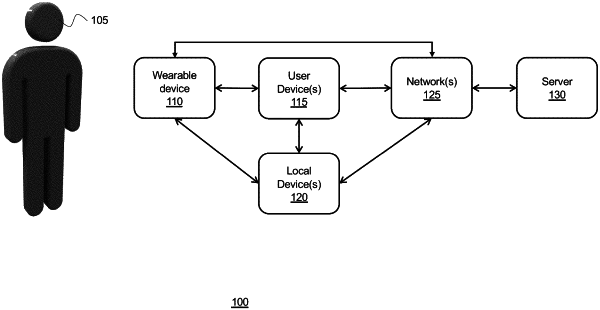| CPC G06F 3/017 (2013.01) [G06F 1/163 (2013.01); G06F 3/013 (2013.01); H04W 4/021 (2013.01); H04W 4/026 (2013.01); H04W 4/027 (2013.01); H04W 4/029 (2018.02)] | 20 Claims |

|
1. A system, the system comprising:
a wearable device configured to be worn on a portion of an arm of a user, the wearable device comprising:
a plurality of electrodes disposed on an interior of the wearable device and configured to obtain biopotential signals from the user's arm;
a biopotential microchip, the biopotential microchip comprising:
one or more analog inputs configured to be coupled to and receive the biopotential signals from the plurality of electrodes, at least one of the one or more analog inputs being coupled to a respective differential amplifier configured to amplify differences in signals between pairs of electrodes;
one or more analog-to-digital converters (ADCs), the one or more ADCs being configured to convert the biopotential signals to biopotential data;
an accelerometer, the accelerometer being disposed onboard the biopotential microchip and configured to output acceleration data indicating an acceleration of the portion of the user's arm;
a gyroscope, the gyroscope being disposed onboard the biopotential microchip and configured to output angular rate data indicating an angular rate of the portion of the user's arm; and
a processor, the processor being configured to process the biopotential data outputted by the one or more ADCs, the acceleration data outputted by the accelerometer, and the angular rate data outputted by the gyroscope;
wherein the biopotential microchip is an integral unit and has all of the processor, the gyroscope, the accelerometer, the one or more analog inputs, the ADCs, located on a common unitary substrate,
wherein the biopotential microchip is configured to output, directly or indirectly, the biopotential data outputted by the one or more ADCs, the acceleration data outputted by the accelerometer, and the angular rate data outputted by the gyroscope, or derivatives thereof (collectively, data), to a machine learning classifier, the machine learning classifier being configured to generate, based on the data, an output indicating a parameter of the user,
wherein the biopotential microchip comprises either:
(a) a first low-power state in which the one or more ADCs and the differential amplifiers are not enabled but the accelerometer and the gyroscope are enabled; and an active state in which each of the one or more ADCs, the differential amplifiers, the accelerometer, and the gyroscope are enabled, or
(b) a second low-power state in which the accelerometer and the gyroscope are powered down but at least the one or more ADCs are active.
|